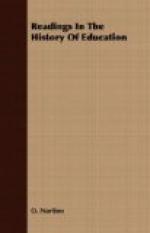1. The Decree of Gratian (Decretum Gratiani) in three parts, published c. 1142. Part I contains one hundred and one distinctions (distinctiones) or divisions, which treat of matters relating to ecclesiastical persons and offices. Dist. XXXVII is translated below. Part II contains thirty-six cases (causae) each of which is divided into questions (quaestiones). These questions deal with problems which may arise in the administration of the canon law. Part III contains five distinctions which deal with the ritual and the sacraments of the church. Under each distinction, or question, are arranged the canons—the views of ecclesiastical authorities—on the matter under discussion.
2. The Decretals
(Decretales), in five books, published by Pope
Gregory IX in 1234.
3. The Sixth Book
(Liber Sextus), a supplement to the Decretals
by Pope Boniface VIII,
1298.
4. The Constitutions
of Clementine (Constitutiones
Clementinae), 1317.
5. Several collections
of papal laws not included in those above,
known by the general
title of Extravagantes, i.e., laws extra
vagantes, or outside
of, the four compilations just mentioned.
Among all these the Decretum of Gratian was the great innovation which first marked out Canon Law as a distinct field of learning, separate from both Theology and Roman Law. It was written as a text-book; “it was one of those great text-books which take the world by storm.” It created an entirely new class of students, separate from those devoted to Arts, Theology, Roman Law, and Medicine,—just as the development of Engineering and other new professional studies have created new groups of university students to-day,—and thereby increased the resort to the universities.
The selection following illustrates numerous characteristics of mediaeval university study. (1) The question itself is a very ancient subject of debate; the controversy, on religious grounds, concerning the study of the classics, had already continued for nearly a thousand years, and was destined to continue for centuries after the appearance of the Decretum. Many such questions were debated in the universities for generations. The debate on the classics still rages, though the arguments pro and con no longer raise the point of their influence on religious belief. (2) The selection is one among many examples of the powerful influence of Abelard’s method in mediaeval writing and teaching. The reader will at once see in it the form of the “Yes and No.” (3) It gives a very good idea of the substance of a university lecture, which would ordinarily consist in reading the actual text and comments here set down (see p. 111). (4) It shows how the mass of comments came to overshadow the original text, and by consequence to absorb the greater part of the attention of teachers




